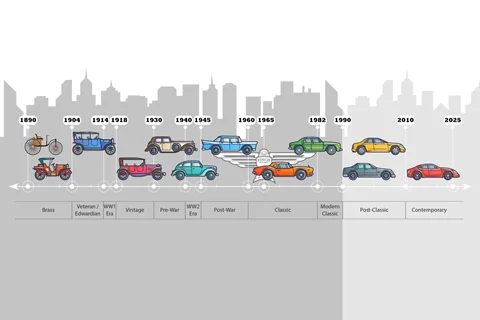
Across the world, enthusiasts and professionals alike recognise that classic car restoration estimates can vary widely. While we use disciplined methods and decades of experience, restoration is not a linear process — it’s an unfolding journey that often reveals hidden challenges. This FAQ explores why estimates shift, how we approach uncertainty, and what the global restoration industry says about the same issue.
Read more: Why Are Vehicle Restoration Estimates So Uncertain?

There is no universal system for defining vehicle eras. Finch Motor Company’s classifications align with historical milestones, restoration needs, and global standards, ensuring accurate representation of each era’s design, engineering, and craftsmanship.
Read more: Why does Finch use vehicle 'Era' classifications?
Although our workshops are located in South Australia, we regularly take on vehicle restoration projects from clients across Australia — including from Melbourne, Sydney, Brisbane, Perth, Canberra, Darwin, and Hobart.
From subtle refinements to full custom builds, we modify classic cars to suit your vision. Explore our performance, aesthetic, and EV options.
Read more: Can you perform modifications or custom builds on classic vehicles?
Need transport for your classic car? We arrange specialist vehicle transport, even for non-running or partially dismantled projects.
Read more: Can you arrange transportation for my vehicle to your workshop?
Estimating restoration costs involves labour, parts availability, and unforeseen challenges.
Read more: How is the cost of a vehicle restoration estimated?
Restoration costs are based on time and materials, ensuring flexibility and transparency. Learn why fixed pricing isn’t practical.
Read more: Do you provide fixed-price restorations, or is it time-and-materials based?
A restored classic needs proper care to stay in top shape. Discover key maintenance tips to preserve its condition for years to come.
Read more: How should I maintain my classic car after restoration?
Restoring a classic to 'factory condition' means balancing authenticity with precision. Discover what this process truly involves.
Read more: What does restoring a classic car to factory condition involve?
Classic cars were built with inconsistencies in panel fit and finish. Learn how these variations impact restoration decisions.
Read more: How do factory variations affect classic car restoration?
Factory-original restorations replicate period quirks, while blueprint restorations refine them. Which approach suits your classic car?
Read more: How Concours judging influences restoration decisions & Client Goals?
Concours judging values authenticity, condition, and presentation. Learn how restoration decisions align with these prestigious standards.
Read more: Original Factory Condition vs. Blueprint Restoration – the Difference?
Vehicle restoration follows a structured process—from disassembly to final testing. Discover the key stages that bring classics back to life.
Read more: What are the key stages of a vehicle restoration?
Severe rust or structural damage doesn’t always mean the end of a classic car. Find out what’s possible and how we approach restoration.
Read more: Can you restore vehicles with extensive rust or structural damage?
Parts availability can shape a restoration’s timeline and approach. See how we source, fabricate, and manage hard-to-find components.
Read more: How does parts availability impact the restoration process?
We balance authenticity, longevity, and functionality when sourcing parts—whether original, remanufactured, or modern replacements.
Read more: Do you use original parts, remanufactured parts, or modern replacements?
Restoration costs depend on vehicle condition, parts availability, labour intensity, and the desired restoration level. Let's break it down.
Full restorations take time—typically 12 months to several years—depending on complexity, parts availability, and project scope.
Choosing a car for restoration? Key factors include history, sentimental value, structural integrity, and parts availability. Let’s assess yours!
Read more: How do I know if my car is a good candidate for restoration?
Restoration revives a car to its original glory, refurbishment improves its condition, and repairs address specific issues. Which suits your needs?
Read more: What is the difference between a restoration, refurbishment, and repair?
